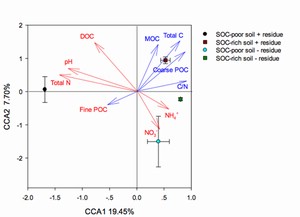|
|
Highlight on microbial molecular ecology associated with the fate of soybean residue-carbonin Mollisols |
|
The soil organic carbon (SOC) in Mollisols in northeastern China have decreased significantly over the past several decades. The average annual rate of SOC decline in the 0- to 90-cm soil profile is approximately 0.9%. In order to minimise or prevent this decline, the return of crop residues to the field is an important practice, especially the residue of soybean that is a major crop in rotation with cereal crops in Mollisols. A limited number of studies have shown that the return of crop residue could maintain or increase SOC in Mollisols, but the effect of crop residues on SOC content and stability may vary between different Mollisols due to the biochemical variation in soils, which mediates the decomposition process. How soil microbes respond to residue amendment, and whether the microbial community composition varies in different Mollisols remain largely unknown. Such investigation will help us to understand the SOC geological distribution in this region and properly manage the soil productivity in Mollisols. Dr. Tengxiang Lian, under the supervision by Jian Jin, found the greater contribution of root residue to SOC stock compared to stalk and leaf residues using 13C-labelling technology (Lian et al., 2016, Biology and Fertility of Soils). Moreover, the fate of soybean residue-C in two Mollisols differing in SOC (14 and 50 g/kg)has been further traced. The amounts of residue-C incorporated into the coarse particulate organic C (POC), fine POC and mineral-associated C (MOC) fractions were 4.5-, 4.3- and 2.4-fold higher in the SOC-rich soil than in the SOC-poor soil, respectively. Interestingly,residue amendment had stronger priming effect in the SOC-poor soil, stimulating the C exchange rate between fresh and native SOC. We also deployed MiSeq sequencing to analyse soil bacterial community composition in response to residue amendment at the operational taxonomic unit (OUT) level.Genera Verrucosispora, Xanthomonadalesand Steroidobacterwere mainly enriched in the residue-amended SOC-poor soil whileAnaerolineaceae_uncultured was dominantin the SOC-rich soil (Figure 1). The canonical correspondence analysis (Figure 2)revealed that the relative abundance of the bacterial OTU among residue treatments was significantly associated with soil characteristics, especially C content in coarse POC and MOC fractions(p < 0.01)(Lian et al.m 2017, Soil Biology & Biochemistry). These results would be essential to the residue-return strategy and important to underpin the mechanisms of residue turnover in soil.  Figure 1. The relative abundances of bacteria at the genus level inMollisols  Figure 2. Canonical correspondence analysis (CCA) Publications Tengxiang Lian, Jian Jin, Guanghua Wang, Caixian Tang, Zhenhua Yu, Yansheng Li, Junjie Liu, Shaoqing Zhang, Xiaobing Liu.The fate of soybean residue-carbon links to changes of bacterial community composition in mollisols differing in soil organic carbon.Soil Biology and Biochemistry,2017,109, 50-58. http://www.sciencedirect.com/science/article/pii/S0038071717301426 Lian T, Wang G, Yu Z, Li Y, Liu X, Jin J. Carbon input from 13C-labelled soybean residues in particulate organic carbon fractions in a Mollisol. Biology and Fertility of Soils, 2016, 52, 331–339.https://link.springer.com/article/10.1007%2Fs00374-015-1080-6
|
|
|

